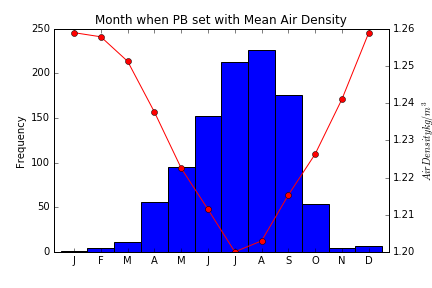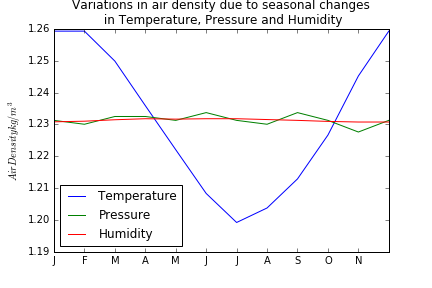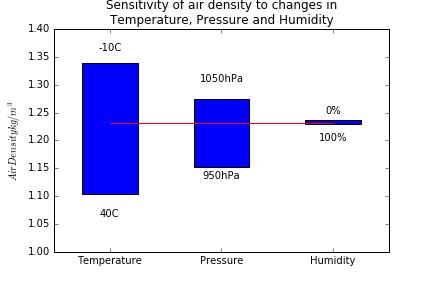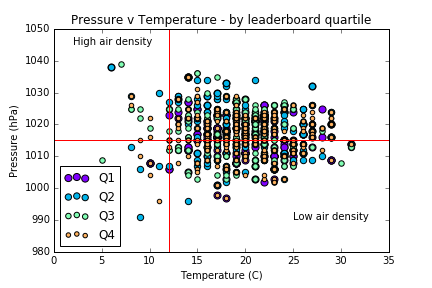This is the third in a series of articles investigating factors that determine the best times on Strava leaderboards, using the popular Tour de Richmond Park segment as a case study. So far we have established that the fastest times have tended to be in the summer, with a decent wind blowing from the East. This blog investigates how atmospheric conditions affect the density of air, which, in turn, determines the aerodynamic drag that a cyclist needs to overcome.
The power required to offset the mechanical forces, of gravity and rolling resistance, increases in proportion to speed, but the power needed to overcome aerodynamic drag rises with the cube of velocity. When riding fast, your effort goes principally into overcoming drag: maintaining a speed of 50kpm requires almost double the power of riding at 40kpm (503/403 = 125/64 = 1.95). The aerodynamic drag force is proportional to the density of the air though which a cyclist is pushing both body and bike. So you have a better chance of winning a KOM (or QOM) when the air density is low.
A previous blog noted that most personal bests (PBs) on the Richmond Park leaderboard were set in the summer. The following chart superimposes, in red, the average air density in London on a histogram showing the number of PBs set in each month. The trough in the air density implies that aerodynamic drag is about 5% lower during the warmer months.

So how much difference would a 5% reduction in air density make to your time round Richmond Park? For the same power, the cube of your speed can go up by 5%, resulting in a reduction of your PB time of 1.6%. For example, a cyclist completing a lap of Richmond Park in 16 minutes and 16 seconds (averaging 40kph) in December, would finish in 16 minutes dead, at exactly the same average power, in the less dense air of July. The difference is a second per minute, which equates to a saving of a minute for a one hour TT.
The air density depends on temperature, pressure and humidity. The reason that air density is lower in the summer is that temperatures are higher: warm air expands. Monthly mean atmospheric pressure is pretty much the same all year round. Humidity tends to be higher in the winter. Contrary to what most people think, higher humidity reduces air density (because water vapour, H2O, with a molecular mass of 18, is lighter than the main constituent of air, nitrogen, N2, which has a molecular mass of 28). However, as the following chart shows, changes in humidity have a tiny effect on air density relative to changes in temperature.

Although temperature is the primary determinant of seasonal variations in air density, both atmospheric pressure and humidity can vary significantly from day to day, so it is important to consider these factors when aiming for a KOM. The next chart shows the variability of air density, measured on a particular day, for an extreme range of temperatures, pressures and humidities.

When Bradley Wiggins was going for the hour record, he became obsessed with the weather forecast, because even though it was possible to raise the temperature and humidity in the velodrome, he ideally needed a low pressure weather system to pass over the UK at the same time, as this would have further reduced the density of the air that he was riding through. On 2 May 2015, the air pressure in Manchester, which is close to sea level, was 1009hPa. If it had been about 3% lower, at say 980hPa (historically very low), he should have been able to go about 1% further, to exceed 55km.
Since Strava segments tend to be outdoors, your priority should be to choose a very warm day, ideally with low atmospheric pressure and not worry too much about humidity, though higher is better. Returning to the leaderboard for the Tour de Richmond Park segment, the final chart shows the temperature and pressure on the days that the top 1000 PBs were set, split into quartiles of 250 riders (fastest riders in Q1).

Observe that most records were set when the temperature was well above the annual mean of 12 °C, shown by the vertical red line. Slightly more PBs were set when the atmospheric pressure was disadvantageously higher than the average horizontal red line. There was no significant difference in air density for the top 250 riders versus the other groups of 250. Clearly the best place to be is the lower right quadrant. Finally, we have found something that would have allowed Rob Sharland to improve upon his KOM, as the prevailing conditions were 21 °C and 1022hPa – a warmer day with a lower atmospheric pressure would have helped him go faster – but then he might not have had the ideal wind conditions noted in the previous blog. The relative importance of wind versus air density is something I hope to come back to.
The next blog explores the factors relating to the rider and bike that influence the time to complete a Strava segment.


Hi this is excellent information, however there is another variable that for me has a huge impact – that is lower athletic performance in high temperatures and high humidity, especially in hotter humid climates than Europe like here in NC in summer, where temps reach 95 F in July and August, and relative humidity is also very high. The effect of overheating reduces performance significantly. So this counteracts some of the low density effects, more particularly for longer sustained efforts. I would expect mathematically there is a peak in overall performance in some middle ground region .
LikeLike